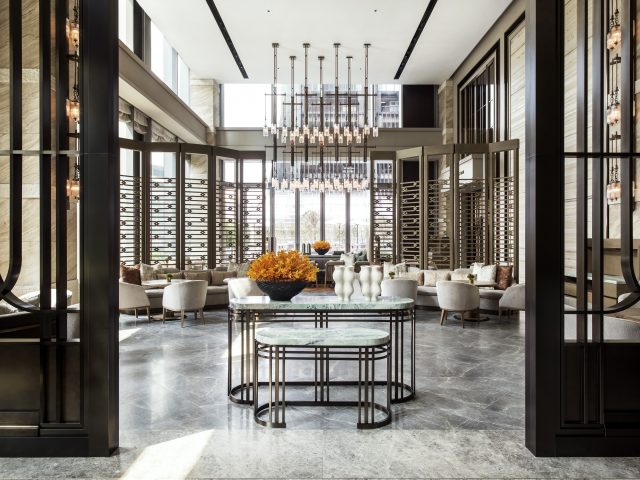
Osaka and Bali are old news. Blessed by frequent and cheap flight routes and one of the highest counts of public holidays in the world, Hong Kong’s location in the heart of Asia puts a cornucopia of wildly different travel destinations within easy reach, so there’s no excuse not to explore a new region with every holiday. Vogue picks the top getaways for your next long weekend below.
Phú Quốc
Image courtesy of JW Marriott Phu Quoc Emerald Bay
Best for those seeking pristine beaches and culinary exploration, Phú Quốc is an island that is coming into its own just off the southwestern coast of Vietnam.
Where to stay: The larger-than-life JW Marriott Phu Quoc Emerald Bay was designed by architect Bill Bensley to resemble the revitalised fictional Lamarck University. Supposedly built in 1880, the 244-room ‘campus’ is themed along academic departments and is dazzlingly ornate both inside and out.
What to eat: Vietnamese foodies flock here for its famed seafood, peppercorns, and nuoc mam fish sauce – make sure to stop by the Red Boat fish sauce factory for a closer look at how this pungent condiment is made.
If you only do one thing: Arrange from the JW Marriott resort for a boat trip to the numerous islands dotting the surrounding sea, with a freshly-cooked seafood lunch served on board by local fishermen.
How to get there: Direct flights to Phú Quốc International Airport depart from Hanoi, Bangkok, and Ho Chi Minh City.
Yaeyama Islands
A great alternative to Okinawa, the tropical Yaeyama island group includes the southernmost possessions of Japan. Ishigaki offers the same relaxed way of life without the crowds, while the surrounding islands of Taketomi and Iriomote are also gems of nature in their own right.
Where to stay: A ten-minute ferry ride from Ishigaki, Taketomi is home to Hoshinoya Taketomi Island, a luxury resort styled by architect Rie Azuma to resemble the traditional low-slung, red-tiled stone houses indigenous to the isle. With an even slower pace of life than on Ishigaki, a water buffalo-drawn wagon is the best way to explore the resort grounds.
Where to eat: Historically the seat of the Ryukyu Kingdom, the Yaeyama Islands feature a unique cuisine that has been equally influenced by China as much as by Japan. Head to Funakura no Sato on the outskirts of Ishigaki City for a creative take on local specialties such as mimiga (thinly-sliced pig’s ears), umibudo sea grapes, and creamy jimami peanut tofu, all washed down with the local awamori liquor.
If you only do one thing: Board a glass-bottomed boat ride at the stunning Kabira Bay, which is one of just two places in Japan where black pearls are cultivated.
How to get there: HK Express offers two direct flights a week from Hong Kong to Ishigaki Airport that take approximately 2.5 hours.
Taichung
The cultural cousin to the cosmopolitan centre of Taipei, the Taiwanese city of Taichung was given a boost in its credentials with the opening of the Toyo Ito-designed National Taichung Theater, although the city has much more up its sleeve thanks to its enviably high standards of living.
Where to stay: True to its more arty nature, Taichung has a refreshing lack of international chain hotels in favour of characterful boutique hotels. Foremost among them is RedDot Hotel, which has a statement-making two-storey metal slide to welcome visitors in the lobby.
Where to eat: Despite closing her fine dining restaurant Le Moût last year, 2014 Asia’s Best Female Chef Lanshu Chen continues to operate Gubami, a noodle eatery serving high-end traditional beef noodles that also hides a secret cocktail bar for those in the know.
If you only do one thing: The National Taiwan Museum of Fine Arts is one of the largest and most important cultural institutions in the region – budget the better part of a day to make a dent in this public museum’s 24 exhibition halls.
How to get there: Multiple airlines offer direct flights from Hong Kong to Taichung, taking approximately 1.5 hours.
Guizhou
This interior Chinese province is shedding its reputation as the country’s poorest region to become an up-and-coming destination thanks to the cultural richness of its diverse and well-preserved tribal cultures. Interspersed with centuries-old rice paddies, Guizhou’s mountainous terrain makes for some spectacular fog-bound scenery.
Where to stay: The five-star Kempinski in the provincial capital of Guiyang provides a plush base from which to explore the surrounding old villages.
Where to eat: Famed for its spicy cuisine, Guizhou natives like their food blazingly hot. Get a taste of this unique palate with a bowl of chilli sauce noodles at Luojilao in Guiyang.
If you only do one thing: A two-hour drive south from Guiyang, the village of Suoga is home to the Changjiao subgroup of the Miao ethnic minority, who are known for their hulking buffalo-horned headpieces that are worn on the daily. The Miao are renowned for their silver ornaments and elaborate embroidery, so don’t leave town without picking up a few keepsakes.
How to get there: You can reach Guiyang in 5.5 hours by high-speed rail from West Kowloon station. Alternatively, Hong Kong Airlines offers a 2-hour direct flight.
Editor
Gavin YeungCredit
Header image courtesy of JW Marriott Phu Quoc Emerald Bay




